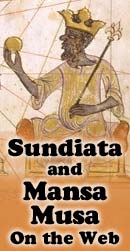Primary Sources
Sundiata Epic | Al-Umari | Al-Bakri | Ibn Battuta | Catalan Atlas | Leo Africanus | Multiple sources
Sundiata Epic
See Sundiata : Sundiata Epic for links on this source.
Al-Umari
Al-Umari's description of Mansa Musa's 1324 visit to Cairo, the longest, best selection on the web. Also includes shorter selections from Ibn Battuta and Ibn Khaldun, translated by Joseph Kenny, from his The Spread of Islam Through North to West Africa: A Historical Survey with Relevant Arab Documents (2000).
Al-Umari's description of Mansa Musa's 1324 visit to Cairo and the consequent depression of the value of gold, from Levitzion/Hopkins Corpus of Early Arabic Sources for West African History. Includes some questions, evidently by Dorian Bowman. Text courtesy Boston University's African Studies Center.
Al-Bakri
Al-Bakri's description of the Kingdom of Ghana (11c.) from Levitzion/Hopkins, Corpus of Early Arabic Sources for West African History. Some questions, evidently by Dorian Bowman. Text courtesy Boston University's African Studies Center.
Other, partially-overlapping selections from Al-Bakri on Kingdom of Ghana are available at this World Books sub-site. Unfortunately, there's no information on where the text comes from, who edited or who is responsible. I found it by searching for phrases from the BU translation. Use with caution.
Ibn Battuta
For Ibn Battuta's travels see my site Ibn Battuta on the Web. The section on Sub-Saharan Africa is partially excerpted here.
 Amazon. Ibn Battuta in Black Africa
by Ibn Batuta. Selections from his writings are translated and commented upon by Said Hamdun and Noel Quinton King.
Publisher's blurb.
Amazon. Ibn Battuta in Black Africa
by Ibn Batuta. Selections from his writings are translated and commented upon by Said Hamdun and Noel Quinton King.
Publisher's blurb.
Ibn Battuta and his Saharan Travels from Ibn Battuta in Black Africa by Said Harridun and Noel King. With some additions by Jim Mann Taylor.
West Africa, as seen by Ibn Battuta by Jim Jones, West Chester University. Lecture for Jones' course African History to 1875 , following and commenting on Hamdun and King's Ibn Battuta in Black Africa. It's off the subject, but you gotta love a guy whose homepage lists "Six unusual things about Jim Jones," including "Hitchhiked across the Sahara Desert three times."
A few study questions on Ibn Battuta in Black Africa(William J. Wright, University of Tennessee). [mirror]
Journey to West Africa (1351 - 1353) from Nick Bartel's site Ibn-Battuta site.
Catalan Atlas
The Catalan Atlas is the source of most images of Mansa Musa, including the one here (see navigation bar). This figure is labelled "Musse Melly," with a description of who he is. There is, of course, no reason to believe the depiction comes from any source other than a cartographer's imagination. Here is the full map.
Translation of the Catalan Map from Jim Mann Taylor's entertaining 153 Club (named after the Michelin guide for the region). It reads:
"This Negro lord is called Musa Mali, Lord of the Negroes of Guinea. So abundant is the gold which is found in his country that he is the richest and most noble king in all the land."
About the Catalan Map from the very complete website Cartographic Images.
Leo Africanus
(Yes, he's much later. I know. I know.)
Leo Africanus: Description of Timbuktu (1526) translated by Paul Brians.
"Leo Africanus: The Man with Many Names" by Pekka Masonen, from Al-Andalus-Magreb. Revista de estudios árabes e islámicos (2002). Fascinating article.
"Leo Africanus should not be viewed only as a curious anecdote who belongs to the national biographies of Spain, Morocco, and Italy, and to the historiography of travels and discoveries. His life and work still have a relevance to our own times. Leo Africanus is a splendid example of the passage of men and of intellectual elements between the two shores of the Mediterranean. The experiences of Leo Africanus clearly prove that the religious, ethnic, and cultural borders between the Islamic and Christian worlds were not insuperable even in the distant past—and nor should they become insuperable in the near future either. He was not, however, a true Renaissance man who embraced the values of Renaissance Italy to the point of rejecting his old customs. Nor was he any paragon of a modern cross-cultural cosmopolite who was at home wherever he went. The originality of Leo Africanus lies in the fact that he wrote his work in Europe, and was most influential there, despite the man himself belonged intellectually to the Arab world."
Leo Africanus on Timbuktu in the 16th century . Includes some questions, evidently by Dorian Bowman. Text courtesy Boston University's African Studies Center. Leo's English is a bit antiquated…
Multiple sources
The Songhay Empire According to Ta’rîkh al-Fattâsh, Ta’rîkh as-Sûdân and Leo Africanus. Source selections from The Spread of Islam Through North to West Africa: A Historical Survey with Relevant Arab Documents, by Joseph Kenny (2000).
Amazon. Corpus of early Arabic sources for West African history, translated by J.F.P. Hopkins; edited and annotated by Hopkins and N. Levtzion. Excerpts many authors (some excerpts below). Apparently out-of-print in hardcover. The Publisher's blurb excerpts the TLS review, which complains of the hardcover version "Only its grotesque price will prevent it from reaching the shelves of the teachers of West African history for whom it was designed."

If you enjoy this site you may also like these other sites by me:
Ibn Battuta on the Web. Comprehensive guide to the 14th century Muslim traveler, Ibn Battuta on Morocco, and his Rihla.
Ibn Khaldun on the Web. Web directory and guide to the great 14th century Arab historian and philosopher of history.
